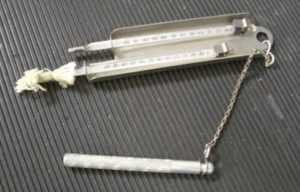Model Description
This is a demonstration designed to introduce the basic concepts of psychrometry, the adiabatic saturation or wet bulb temperature, sling psychrometers and the ASHRAE comfort zone. This demonstration should take 8-10 minutes.
Engineering Principle
This demonstration is best used in a Thermodynamics course when the topic of psychrometrics is introduced. It is designed to provide students with a basic understanding of air-water vapor mixtures, how a sling psychrometer works, and how to plot a state point on a psychrometric chart.
What You Need
| Item | Quantity | Description/Clarification |
|---|---|---|
| Thermometer | 2 | Simple, mercury thermometers work best. |
| Cloth wick | 1 | A piece of cloth to cover the bulb of one of the thermometers. |
| Bracket | 1 | Some device to hold the two thermometers together and expose the bulbs to ambient air. |
| Chain or string | 1 | Approximately 6-8 inches to allow the user to sling the psychrometer through the air. |
How It’s Done
Before Class: Build or obtain the components to build the sling psychrometer. Also, obtain a copy of the psychrometric chart from ASHRAE. A version of this chart appears in the FE Reference Manual and in many Thermodynamics textbooks. A technique is to enlarge the chart on an easel or in a PowerPoint presentation in addition to giving a copy to each student.

In Class: Discuss the psychrometric chart, how to read it, and explain the concept of the comfort zone. Discuss the psychrometer, and the concept of the adiabatic saturation temperature. Demonstrate the sling psychrometer (figure below) and record the values of the dry and wet bulb temperatures. Plot these points on the psychrometric chart to determine whether the room is in the comfort zone. This can also lead to a discussion on air-conditioning processes such as heating, cooling, humidification and de-humidification.

Observations: Students should be able to see how the temperature changed on the wet bulb thermometer after the demonstration. Ask the students if the change in temperature would be larger or smaller if the air had a higher humidity ratio.
Additional Application: Develop a scenario early in the lecture in which one person in the class has the task of determining whether the classroom is in the comfort zone or not. Then develop the definitions of dry air, water vapor, mixtures, humidity ratio, and relative humidity. None of these terms will present a particularly easy method of determining if the room is in the comfort zone or not. Finally, introduce the adiabatic saturation temperature term and the sling psychrometer. Time the demonstration so that it occurs near the end of the lecture to build suspense toward the final determination of the state of the room. Pick up next lesson with total air-conditioning processes (if taught) as a transition to how to move into the comfort zone.
